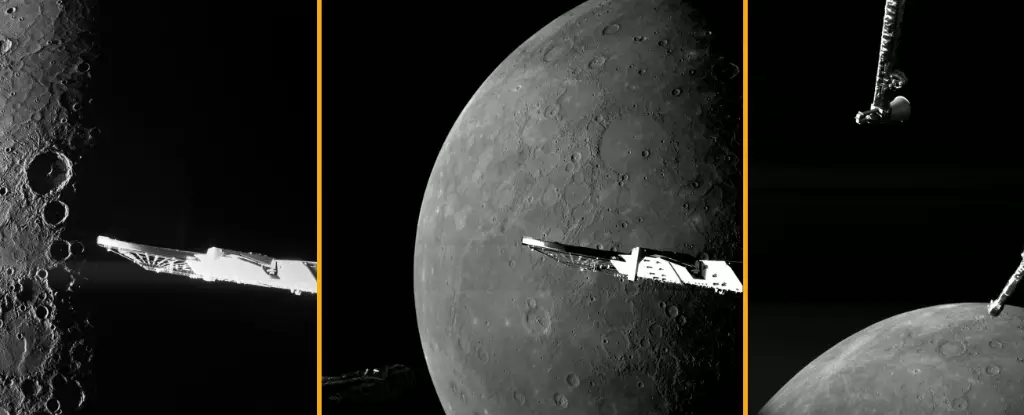Mercury, the innermost planet of our solar system, has long captivated astronomers and scientists alike with its peculiar characteristics and enigmatic qualities. Recently, the European Space Agency’s (ESA) BepiColombo mission has elevated our understanding of this sun-scorched world. The probe, which is en route to study Mercury, recently executed a crucial flyby that brought it within a mere 295 kilometers of the planet’s rugged surface, providing unprecedented close-up images that reveal a landscape shaped by extremes.
These new images showcase a planet caught in stark contrasts—intense sunlight bleeds into areas of perpetual darkness. This interplay of light and shadow not only exemplifies Mercury’s harsh conditions but also hints at hidden features. Scientists speculate that within these permanently shadowed regions may lie water ice, a substance that could hold keys to unraveling Mercury’s geological history and, perhaps, its potential for hosting life in some primordial form.
Geraint Jones, the ESA Project Scientist leading the BepiColombo mission, articulated the excitement surrounding these new data points. The team is optimistic about what these images can reveal regarding the planet’s composition, geological processes, and magnetic anomalies. Although the primary scientific operations won’t commence until 2027, the wealth of information gathered during this flyby is expected to be pivotal in charting new territories in our understanding of Mercury.
Mercury is often described as a peculiar planet, particularly when compared to its celestial neighbors. Classically regarded as a planet of extremes, it hovers just 58 million kilometers from the Sun, perpetually battered by intense solar radiation and stripped by the relentless solar wind. The planet’s atmosphere, if it can be termed as such, is an ephemeral mix of gases that is replenished through meteoritic impacts and solar activity, offering only a thin veil of protection against the harsh conditions.
The surface of Mercury is an unforgiving arena, where temperatures soar up to 430 degrees Celsius (800 degrees Fahrenheit) during the day. However, the absence of an efficient atmospheric system means nights can plunge to a frigid -180 degrees Celsius. Such drastic temperature fluctuations present an intriguing puzzle, leading scientists to ponder the mechanisms underpinning Mercury’s mysterious magnetic field and the planet’s potential internal structure, which may even include diamonds formed from carbon deposits deep within its crust.
The recent flyby also yielded remarkable geological observations. Among the features captured is the Nathair Facula, identified as the site of the largest volcanic explosion known on Mercury. This feature is embellished with signs of past activity, evidenced by its sizeable volcanic vent, which spans approximately 40 kilometers. Adjacent to this is the relatively youthful Fonteyn crater, believed to have been formed a mere 300 million years ago, showcasing the planet’s dynamic geological history.
The gathered images further suggest a landscape shaped by centuries of impact events and volcanic activity—evidence that Mercury may not be the static world it appears to be. The data point towards a narrative of gradual darkening over eons, interlaced with moments of intense rejuvenation prompted by significant impacts or other geological events.
BepiColombo is a joint effort between ESA and the Japan Aerospace Exploration Agency (JAXA), and its mission is set to culminate in 2026 with the deployment of two separate orbiters aimed at distinct scientific goals. These orbiters—the Mercury Planetary Orbiter and the Mercury Magnetospheric Orbiter—are slated to commence their detailed explorations in 2027. While they won’t venture as close to Mercury as the BepiColombo has during its flybys, they will gather invaluable data from various altitudes and orientations.
As the BepiColombo mission unfolds, our understanding of this mercurial planet is poised to expand significantly. Scientists anticipate that the comprehensive dataset from this mission will shed light on Mercury’s complex history, its present conditions, and its possible future—essentially rewriting what we know about this little-explored world at the edge of our solar system. The journey of discovery is just beginning, and with it, our cosmic narrative grows ever richer.

Leave a Reply